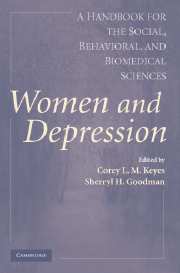Book contents
- Frontmatter
- Contents
- List of Contributors
- Foreword
- Preface
- PART I NOSOLOGY, MEASUREMENT, AND THE EPIDEMIOLOGY OF WOMEN AND DEPRESSION
- PART II BIOLOGICAL, DEVELOPMENTAL, AND AGING MODELS OF RISK
- PART III COGNITIVE, EMOTIONAL, AND INTERPERSONAL MODELS OF RISK
- PART IV SOCIAL, POLITICAL, AND ECONOMIC MODELS OF RISK
- PART V SYSTEMS AND PROCESSES OF TREATMENT, PREVENTION, AND POLICY
- 17 Services and Treatment for Depression
- 18 Prevention of Depression in Women
- 19 Women and Depression
- Author Index
- Subject Index
- References
19 - Women and Depression
Research, Theory, and Social Policy
Published online by Cambridge University Press: 05 June 2012
- Frontmatter
- Contents
- List of Contributors
- Foreword
- Preface
- PART I NOSOLOGY, MEASUREMENT, AND THE EPIDEMIOLOGY OF WOMEN AND DEPRESSION
- PART II BIOLOGICAL, DEVELOPMENTAL, AND AGING MODELS OF RISK
- PART III COGNITIVE, EMOTIONAL, AND INTERPERSONAL MODELS OF RISK
- PART IV SOCIAL, POLITICAL, AND ECONOMIC MODELS OF RISK
- PART V SYSTEMS AND PROCESSES OF TREATMENT, PREVENTION, AND POLICY
- 17 Services and Treatment for Depression
- 18 Prevention of Depression in Women
- 19 Women and Depression
- Author Index
- Subject Index
- References
Summary
The World Health Organization (WHO) has found gender differences in depression in all regions of the globe and has identified clinical depression as a leading cause of disease-related disability among the world's women (Demyttenaere et al., 2004). Depressive illness is known to be associated with (Hudson et al., 2003) and to affect the clinical course of certain medical illnesses (or risk factors for illness; Frasure-Smith, Lesperance, & Talajic, 1993; McEwen, 2003; McEwen & Lasley, 2002). Further, clinical depression has been found to have multiple social roots associated with inequality, powerlessness, and devaluation, including poverty and hunger, discrimination, poor working conditions, violence, and unwanted pregnancy (Desjarlais, Eisenberg, Good, & Kleinman, 1995; McGrath, Keita, Strickland, & Russo, 1990; Ustun & Sartorius, 1995; WHO, 2000). Given the personal, social, and economic impact of depression on women, their families, and society, policy issues take on new urgency.
The fact that depression is so strongly associated with powerlessness and devaluation makes a feminist analysis that values women and seeks to empower them particularly relevant (Worell, 2001). Feminists across the disciplines have taken the lead in fostering research and treatment approaches to women's mental health (Carmen, Russo, & Miller, 1981; Rieker & Carmen, 1984; Russo, 1984, 1995; White, Russo, & Travis, 2001a). In doing so they have begun to identify gender-related aspects of women's roles and life circumstances that contribute to women's risk for depression.
- Type
- Chapter
- Information
- Women and DepressionA Handbook for the Social, Behavioral, and Biomedical Sciences, pp. 479 - 522Publisher: Cambridge University PressPrint publication year: 2006
References
- 4
- Cited by



